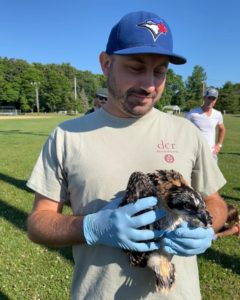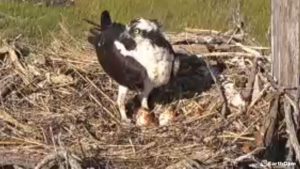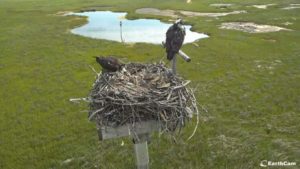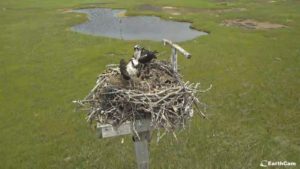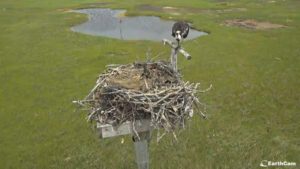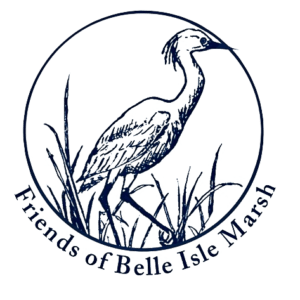Well for those of you watching our nest cam, we have a successful nest this season ! Our pair who Nanci is calling Bella ( female) and Goffo ( male) laid and hatched 3 eggs. So we currently have 3 chicks in the nest. As the egg laying period is stuttered by a few days, our youngest chick is notably smaller than its siblings. We are hopeful that all 3 chicks will survive, but this is often not the case. The older and more dominant chicks will often push the runt of the group to the side, so that they are fed more food. Additionally if the adults begin to feel that the smaller chick will not make it, they will stop feeding the chick as to not waste food and resources. The good news is, Goffo, while he is a menace with sticks and trash, he is actually an excellent fish provider, so there is still a good chance for our smallest chick !
Often we get asked, well why don’t you step in and intervene. Well, the answer is that, the purpose of the camera is to observe the natural life of these animals, not interfere with it. Often life can be tough on wildlife, but nature has a process to weed out the weak. While I will go out to the nest and sometime remove dangerous human trash, I will not interfere with natural selection. This seems harsh, but in reality less than 90% of all raptors survive their first year of life, so the young need to be strong to survive their first migration south.
Over the next few weeks the chicks will start to transform to adult looking Osprey. At about 6 weeks they will be testing out their wings, and will start to fledge (fly) at the 7-8 week mark, meaning they will be able to fly. At this point they will also be fully grown birds. The Adults will continue to feed the chicks and supplement their food as they learn to hunt. Eventually the adults will take off and start their migration. The chicks may stick around for a few more weeks, but likely will be gone by September.
The adults will go their separate ways for the winter, migrating and over wintering in different locations, and then will return to Belle Isle in the end of March next year to do it all over again. The chicks on the other hand, will stay down south, anywhere from Florida to Central and South America for the first year + of their life, then will return north to try to find their own breeding territory over the following season. Amazing stuff !
I will likely go out and band our chicks at about 4 weeks, so likely 2 weeks from now. Yesterday I was down banding on the South Shore with Norman Smith who has been banding Ospreys down there since 1991 , and we are also partnered with Essex County Greenbelt, who is run by Dave Rimmer up North. There is a great community of folks working on Osprey conservation here in Massachusetts.
Stay tuned ! Feel free to send me any questions to Sean.m.riley@mass.gov
